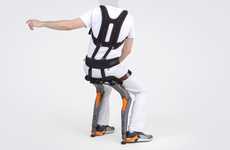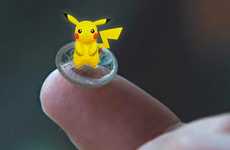
The Skinterface Suit Can Create Tactile Sensations in VR
References: skinterface & digitaltrends
Immersion in virtual reality isn't yet total, but the Skinterface system is hoping to change that. While VR is visually astounding and only promises to improve with advances in computing power and graphics, it is currently all about optics -- at the loss of haptics. The Skinterface system uses a suit covered with small actuators that can vibrate in response to stimulae from inside a VR game or experience.
Skinterface is a project from students at London's Royal College of Art. In its current iteration, the suit allows users to feel sensations on their body, such as a gust of wind or the flow of water. However, the RCA team is aiming to expand Skinterface's capabilities to include manual sensations as well (e.g. something like picking up or touching an object.)
Skinterface is a project from students at London's Royal College of Art. In its current iteration, the suit allows users to feel sensations on their body, such as a gust of wind or the flow of water. However, the RCA team is aiming to expand Skinterface's capabilities to include manual sensations as well (e.g. something like picking up or touching an object.)
Trend Themes
1. Full-body Haptic VR Suits - Opportunity for disruptive innovation: Advancements in haptic technology can revolutionize the virtual reality experience by providing users with realistic tactile sensations.
2. Tactile Sensations in VR - Opportunity for disruptive innovation: Developing technologies that allow users to experience physical sensations in virtual reality opens up possibilities for enhanced immersion and interactive experiences.
3. Expanding VR Haptic Capabilities - Opportunity for disruptive innovation: Innovations that go beyond vibration-based haptic feedback in VR suits can unlock the potential for users to interact with virtual objects and environments more realistically.
Industry Implications
1. Virtual Reality - Opportunity for disruptive innovation: Integration of haptic technology in VR can lead to a new wave of immersive entertainment experiences, training simulations, and therapeutic applications.
2. Gaming - Opportunity for disruptive innovation: Incorporating haptic feedback in gaming experiences can provide players with a more engaging and lifelike interactive environment.
3. Healthcare - Opportunity for disruptive innovation: Haptic VR suits can potentially revolutionize physical and occupational therapy, allowing patients to practice movements and interact with virtual objects for rehabilitation purposes.
5.2
Score
Popularity
Activity
Freshness























